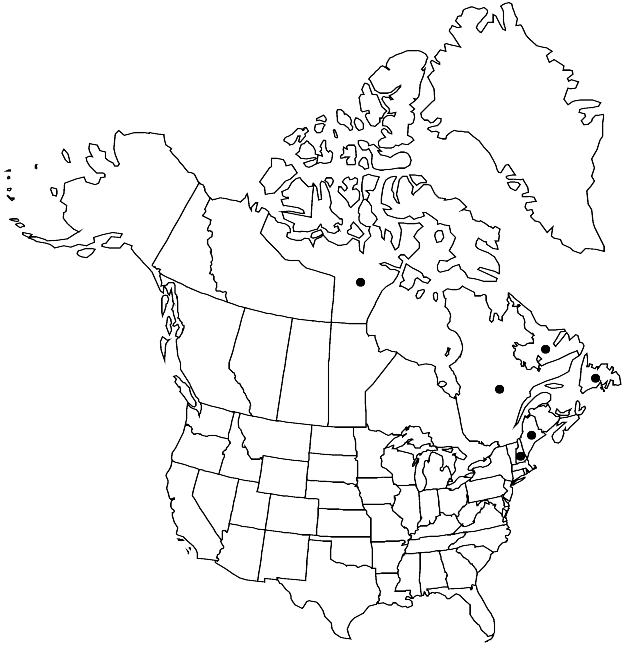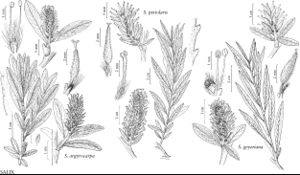Difference between revisions of "Salix argyrocarpa"
Monogr. Salicum, 107, plate 6, fig. 60. 1867.
FNA>Volume Importer |
imported>Volume Importer |
||
| Line 8: | Line 8: | ||
}} | }} | ||
|common_names=Labrador willow | |common_names=Labrador willow | ||
| + | |special_status={{Treatment/ID/Special_status | ||
| + | |code=F | ||
| + | |label=Illustrated | ||
| + | }}{{Treatment/ID/Special_status | ||
| + | |code=E | ||
| + | |label=Endemic | ||
| + | }} | ||
|basionyms= | |basionyms= | ||
|synonyms= | |synonyms= | ||
| Line 54: | Line 61: | ||
|publication title=Monogr. Salicum, | |publication title=Monogr. Salicum, | ||
|publication year=1867 | |publication year=1867 | ||
| − | |special status= | + | |special status=Illustrated;Endemic |
| − | |source xml=https:// | + | |source xml=https://bibilujan@bitbucket.org/aafc-mbb/fna-data-curation.git/src/bb6b7e3a7de7d3b7888a1ad48c7fd8f5c722d8d6/coarse_grained_fna_xml/V7/V7_173.xml |
|genus=Salix | |genus=Salix | ||
|subgenus=Salix subg. Vetrix | |subgenus=Salix subg. Vetrix | ||
Revision as of 23:54, 27 May 2020
Plants sometimes forming clones by layering. Stems: branches red-brown or brownish, not or weakly glaucous, (highly glossy), pubescent to glabrescent; branchlets yellow-brown or red-brown, sparsely pubescent. Leaves: stipules absent or rudimentary on early ones; petiole shallowly grooved adaxially, 3–8 mm, (sometimes glands present distally), pubescent adaxially; largest medial blade narrowly elliptic, narrowly oblong, or oblanceolate 25–65 × 7–15 mm, base cuneate or convex, margins strongly revolute, entire or crenulate, (glands submarginal or epilaminal), apex acute, convex, or acuminate, abaxial surface glaucous (sometimes obscured by hairs), pilose or densely long-silky or villous, (midribs yellow, prominent, glabrous or pubescent), hairs (white, sometimes also ferruginous), straight or wavy, adaxial slightly glossy, glabrous or sparsely pubescent, especially midrib, (hairs white, sometimes also ferruginous); proximal blade margins entire; juvenile blade yellowish green, sparsely to moderately densely long-silky abaxially, hairs white. Catkins flowering as leaves emerge; staminate stout or subglobose, 10–21.5 × 6–10 mm, flowering branchlet 1–8 mm; pistillate densely to moderately densely flowered, stout to subglobose, 11–20.5(–25 in fruit) × 5.5–17 mm, flowering branchlet 1–13 mm; floral bract tawny, brown, or bicolor, 0.7–1.2 mm, apex rounded, abaxially hairy, hairs straight. Staminate flowers: (abaxial nectary 0–0.6 mm), adaxial nectary oblong, narrowly oblong, or square, 0.4–1 mm, (nectaries usually distinct, sometimes cupulate); filaments distinct; anthers purple turning yellow, 0.4–0.5 mm. Pistillate flowers: adaxial nectary narrowly oblong, oblong, or square, 0.3–1.1 mm; ovary pyriform, beak gradually tapering to styles; ovules 12–13 per ovary; styles 0.4–0.9 mm. Capsules 2–4 mm. 2n = 76.
Phenology: Flowering early Jun-early Aug.
Habitat: Floodplains, lake and stream margins, wet snow flush areas, snowbeds, sedge meadows, treed bogs, shrubby tundra, subarctic and subalpine conifer forests, granitic, sandstone, or limestone substrates
Elevation: 10-1800 m
Distribution

Nfld. and Labr., Nunavut, Que., Maine, N.H.
Discussion
Salix argyrocarpa occurs in Nunavut on the Belcher Islands in Hudson Bay.
In the field, Salix argyrocarpa can be confused with S. glauca. They are not closely related but both have staminate flowers with both abaxial and adaxial nectaries, and tawny floral bracts. In subg. Vetrix, this characteristic occurs also in S. wolfii and sometimes in S. orestera, where it may be attributable to hybridization. See 54. S. wolfii for comment.
Vegetative specimens of Salix argyrocarpa and S. pellita are sometimes difficult to separate. There is no evidence that they hybridize.
Salix argyrocarpa is distinguished from S. pellita by having plants 0.2–1 m, stems delicate, largest medial blades 25–65 mm, 3.3–5.9 times as long as wide, branches highly glossy, not or weakly glaucous, flexible at base, and juvenile blades long-silky; S. pellita has plants 0.5–6 m, stems coarse, largest medial blades 40–123 mm, 4.2–11.3 times as long as wide, branches slightly glossy, often strongly glaucous, highly to ± brittle at base, and juvenile blades glabrous or pubescent, tomentose, or short-silky.
Hybrids:
Salix argyrocarpa forms natural hybrids with S. herbacea, S. pedicellaris, and S. planifolia.
Salix argyrocarpa × S. herbacea has leaf shape and margin dentition of S. herbacea but resembles S. argyrocarpa in having leaves glaucous abaxially, along with some white, silky hairs (especially on proximal leaves), juvenile leaves often revolute or infolded, and ovaries glabrous or with patches of hair, hairs appressed, short, straight or slightly curved, and flattened (having a saberlike appearance). These hybrids are sometimes misidentified as S. arctophila × S. herbacea, but ovary hair type and other characters suggest that S. argyrocarpa is the second parent. Occasional specimens with ferruginous hairs on the leaves suggest the influence of S. pellita or S. planifolia.
Salix argyrocarpa × S. pedicellaris (S. ×dutillyi Lepage) resembles S. pedicellaris in leaf shape and size and in having ovaries usually glabrous, although with patches or streaks of hair, and S. argyrocarpa in having leaves sparsely long-silky abaxially, in margins sparsely crenulate, and in proximal leaves with long-silky hairs abaxially. This hybrid is widespread in northern Quebec (G. W. Argus, unpubl.), where backcrosses seem to occur.
Salix argyrocarpa × S. planifolia (S. ×grayi C. K. Schneider): The collector, C. E. Faxon, noted that it could be distinguished at a distance from S. planifolia by its dull white color and upright branching, and from S. argyrocarpa by being taller. It resembles S. argyrocarpa in having juvenile leaves yellow-green, in catkins shorter and borne on longer flowering branchlets, and in stigmas purplish red. It resembles S. planifolia in having juvenile leaves with ferruginous hairs, and in the general appearance of the catkins (M. S. Bebb 1890).
Selected References
None.
